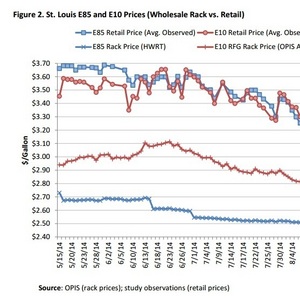New RFA case study shows evidence of E85 price gouging

Renewable Fuels Association
October 8, 2014
BY Renewable Fuels Association
E85 retailers in the St. Louis area may be purposely price gouging Missouri drivers, according to an in-depth case study released today by the Renewable Fuels Association. During the 2014 summer driving season, average E85 prices were 12 percent below gasoline prices at the wholesale level, but 1 percent above gasoline prices at the retail level. Further, the wholesale-to-retail markup on E85 was nearly twice the markup on gasoline. Finally, the study found E85 retail prices were roughly $1 per gallon higher than was justified by wholesale prices for locally available ethanol and hydrocarbon blendstock.
The study’s results offer “… clear support for the notion that some gasoline producers/suppliers and their franchised retailers purposely employ E85 pricing strategies meant to discourage E85 consumption and negatively influence consumer perceptions about the fuel.”
Bob Dinneen, president and CEO of the RFA, stated, “It’s fairly obvious that the retailers examined in this study—all of whom are branded by one of the Big Five oil companies—don’t really want to sell E85. In many cases it appears they were pricing E85 above their branded gasoline for the sole purpose of making their gasoline prices look more attractive to the consumer. Sneaky E85 pricing strategies ultimately give oil refiners the opportunity to wrongly claim that consumers are ‘rejecting’ E85; and it gives them an opportunity to claim they can’t comply with Renewable Fuel Standard (RFS) requirements above the so-called ‘blend wall.’ This study exposes the utter hypocrisy of that argument.”
RFA tracked E85 and gasoline (E10) prices at all nine retail stations selling E85 in the St. Louis metro area. All nine stations carry the brand of one of the five largest integrated oil production and refining companies, which makes the St. Louis E85 market highly unusual because nationwide “…retail stations affiliated with a ‘Big Five’ oil company brand are four to six times less likely to offer E85 than independent or unbranded stations.”
Across more than 250 observations during the summer, the average E10 retail price was $3.452 per gallon and the average E85 retail price was $3.476 per gallon. Meanwhile, E85 was available at a local wholesale terminal for an average of $2.582 per gallon, while E10 averaged $2.933 per gallon at the wholesale level. Based on prices for locally available ethanol, hydrocarbon blendstock, RFS RIN credits, and a typical markup, E85 could have been offered at retail for $2.44–2.55 per gallon.
Advertisement
So, why is the St. Louis E85 market so dysfunctional, when other markets are seeing competitive pricing and strong demand for E85? The study offers several potential explanations:
As RFA pointed out in July, retailers affiliated with a Big Oil brand are often bound by franchise agreements that make it difficult to sell anything other than “branded” fuel. These agreements often set up roadblocks for retailers who wish to sell “unbranded” fuels like E85.
Many oil companies require branded retailers to sell a specified amount of “branded” fuel such as premium or diesel. Therefore, competitively priced E85 would potentially drive sales away from those fuels, leaving retailers in jeopardy of failing to meet contractual obligations.
A small number of consumers purchase E85—no matter the price relative to gasoline—because of ethanol’s environmental benefits. Retailers may be taking advantage of these consumers by keeping E85 prices artificially high.
Advertisement
Due to the relative proximity of the stations offering E85 in the St. Louis market, there is very little price competition to attract FFV drivers to one station over another.
Retailers may be implementing “decoy pricing,” which means they set the price of E85 high so that other fuel options seem more reasonably priced.
“The bottom line is some retailers and their upstream franchisors appear to be employing pricing strategies meant to negatively impact consumer perceptions of E85 and biofuels in general,” Dinneen said. “This is just one more way Big Oil attempts to quash competition and discourage consumers from choosing greener, cheaper, domestically-produced renewable fuels.”
View the study.
Related Stories
The U.S. EPA on May 14 delivered two RFS rulemakings to the White House OMB, beginning the interagency review process. One rule focuses on RFS RVOs and the other focuses on a partial waiver of the 2024 cellulosic RVO.
The U.S. EPA on May 15 released data showing nearly 1.79 billion RINs were generated under the RFS in April, down from 2.09 million generated during the same month of last year. Total RIN generation for the first four months of 2025 was 7.12 billion.
Calumet Inc. on May 9 announced sustainable aviation fuel (SAF) capacity at its Montana Renewables biorefinery is expected to reach 120 MMgy to 150 MMgy sooner than previously reported for a fraction of the originally expected cost.
Tidewater Renewables on May 8 announced that its 3,000-barrel-per-day renewable diesel plant in Prince George, British Columbia, operated at 75% capacity during the first quarter, up from 71% during the same period of last year.
Aemetis Inc. released Q1 results on May 8, reporting increased biogas production, progress with efficiency improvements at the Keyes ethanol plant, and resumed biodiesel deliveries. Financing activities are also underway for a proposed SAF project.
Upcoming Events










